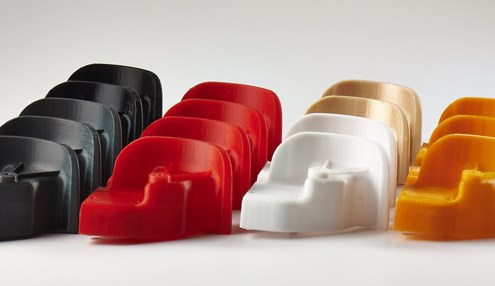Below we’ve highlighted five material considerations to help you find the right material fit for your project:
1. Application
When choosing a material and 3D printing process for your project, you should ensure that your material corresponds with the certifications and/or key characteristics needed for the application. Dependent on where the part is in the product life cycle, you will have different durability needs. For example, a concept model may need to reflect the look and feel of an end product, but doesn’t necessarily need to have the same durability of an end product.
Once you’ve determined the needs of your application, the Material Wizard allows you to filter through all of our available materials that fulfill these requirements by clicking through the Key Characteristics tabs or adjusting the material properties sliders to specific measurements.
2. Aesthetics
As mentioned above, 3D printing materials are often inseparable from technology, and each technology delivers parts at a range of resolutions. PolyJet builds parts with the smallest layer and in full CMYKW color, resulting in highly detailed cosmetic parts. Though we offer expert finishing services, some materials translate better to sanding, polishing and painting than others.
In the Material Wizard you can utilize the Key Characteristics buttons like High Resolution/High Detail, Clear/Translucent, and Flexible to filter through the best materials for highly aesthetic parts.
3. Function
3D printing materials are subjected to rigorous testing in order to answer the kinds of stresses it can endure and the level of taxing environment the material will excel in. Filter through Key Characteristics like Toughness, Flame Retardancy, Impact Resistance and the Material Properties to find the material that corresponds with your application’s primary function.
4. Certifications
Certain 3D printing materials offer biocompatibility, sterilization capabilities, FDA certifications for skin contact, flame smoke and toxicity certifications, chemical resistance or other certifications which may be critical for your project. When choosing a material and 3D printing process for your project, it’s important to ensure your material can deliver what you need. AS a printing service provider with ISO 9001 and AS 9100 certifications, Stratasys Direct Manufacturing can ensure strict material and engineering requirements are met.
While our collection of available 3D printing materials is expansive, it isn’t all inclusive. The breadth of 3D printing material options is growing, bridging gaps between prototype and end-use production. Machine manufactures and third party materials developers have seen huge implications of future evolution to accommodate new and innovative applications.
To learn more about the technology and specifics of 3D printing materials, you can read our white paper Choosing the Right Material for Your Application.

